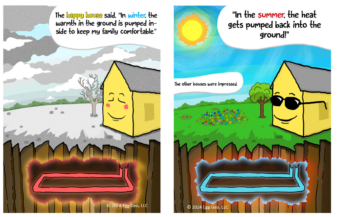Recently, the International Code Council held their Code Action Hearings in Albuquerque, NM. Included on the agenda were what appeared to be innocuous proposals to update the standards that are included in the codes. Typically the standards updates are relatively benign, and incorporate new language to accommodate new technologies. Seldom does a standard update change the level of safety for a particular product, such as is happening with the product listing standard for equipment using flammable refrigerants. In the ICC system, standard updates are considered by the Administrative committee and if they meet the ICC criteria, they are rubber stamped into the next edition.
Unfortunately, this committee is not one to debate or consider the technical aspects within the standards updates being proposed—they simply consider whether the standards meet the ICC criteria, which doesn’t require that the standard be complete before being considered. In this particular case, the UL standard for equipment containing flammable refrigerants was not complete and the exact publish date was still under discussion.
The 2018 and 2021 editions of IMC, IFC and UMC have all rejected the addition of A2L flammable refrigerants in direct HVAC systems until all safety concerns are addressed and the research is complete.
The flammable refrigerants issue has become a very big subject of debate in the codes covering HVAC, refrigeration and fire safety nationwide. In fact, many proposals to add these flammable refrigerants in direct systems, were proposed to the International Mechanical Code committee, the International Fire Code committee, and IAPMO’s Uniform Mechanical Code committee. All were rejected based on multiple aspects including, safety concerns, and incomplete research. The main concern was that the cart was being placed before the horse even before the cart had it’s wheels attached.
There was not a single safety provision related to A2L (flammable) refrigerants for direct air conditioning systems proposed for the International Residential Code (IRC). There was also not a single discussion before the IRC committee even though this committee was chosen for their technical expertise in this area. After the 2021 Code Action Hearings, all of the model codes, nationwide, were in unison in their rejection of proposals to allow these flammable refrigerants for direct HVACR systems in all occupancies, including residential and commercial.
However, there was one loophole still available for those relentlessly pursuing these new flammable refrigerants in all occupancies. They proposed the unfinished standard be included in the IRC to the Administrative Committee.
Proponents desperately trying to go around the technical committees knew that the administrative committee would likely consider only the procedural issues, and not entertain technical debate—the committee is called the “administrative committee” for a reason. Unfortunately, the proponents were correct—instead of rejecting the proposal and putting the responsibility on the proponents to present their case to the appropriate technical committee, they recommended approval and the buck was passed to the membership to determine whether flammable refrigerants should be permitted in the code without any installation requirements.
If this proposal is finalized at the Public Comment Hearing meetings in Las Vegas, there will be absolutely zero provisions in the code to safely install flammable refrigerants in direct HVAC systems in homes. It is important to note that the standard is a product safety standard, not an installation standard. An installation standard is currently under development by ASHRAE, but remains unfinished.
If the standard is confirmed at the Public Comment Hearings, there will be absolutely zero provisions in the IRC to safely install and inspect flammable refrigerants in direct HVAC systems for homes.
The Air Conditioning Contractors of America, multiple fire service organizations and interests and several of the largest manufacturers of refrigerants and equipment all oppose this standard at this time and the use of these refrigerants in direct residential applications.
This must be corrected at the Public Comment Hearings, and most importantly, during the Online Government Vote afterwards. The technical and safety debate must take its proper path and play-out as all other critical lifesafety provisions throughout the history of ICC’s code development process have done. If this action is condoned, what will stop others from timing their standards the same way as they have done here – circumventing all technical and safety debate of the industry and the membership of ICC? This sets a very bad precedent, raises safety concerns and conflicts with the votes of the IMC, UMC and IFC committees..
To the ICC Membership:
The committee must be overturned so that flammable refrigerants will NOT be allowed in homes without a single technical or safety provision included to insure public safety. Please vote to overturn the committee and maintain consistency with the IMC, UMC and IFC code development committees.
 About the author: Jay Peters has been in the industry for almost 40 years as a licensed journeyman plumber, refrigeration journeyman, sheetmetal installer and multi-state contractor. For more than a decade he worked for the two largest code organizations as Executive Director of plumbing, mechanical and fuel gas at the International Code Council (ICC) and Senior Director of Codes and Education at the International Asssociation of Plumbing and Mechanical Officials (IAPMO). Currently he is the principal advisor at Codes and Standards International. His articles have appeared in Plumbing Engineer, IAPMO Official, Plumbing Africa, PM Engineer, Contractor, Reeves Journal, National Envirnomental Health Association Journal, ICC Building Safety Journal and more. Contact: Jay@BuildingCodesAndStandards.com
About the author: Jay Peters has been in the industry for almost 40 years as a licensed journeyman plumber, refrigeration journeyman, sheetmetal installer and multi-state contractor. For more than a decade he worked for the two largest code organizations as Executive Director of plumbing, mechanical and fuel gas at the International Code Council (ICC) and Senior Director of Codes and Education at the International Asssociation of Plumbing and Mechanical Officials (IAPMO). Currently he is the principal advisor at Codes and Standards International. His articles have appeared in Plumbing Engineer, IAPMO Official, Plumbing Africa, PM Engineer, Contractor, Reeves Journal, National Envirnomental Health Association Journal, ICC Building Safety Journal and more. Contact: Jay@BuildingCodesAndStandards.com



